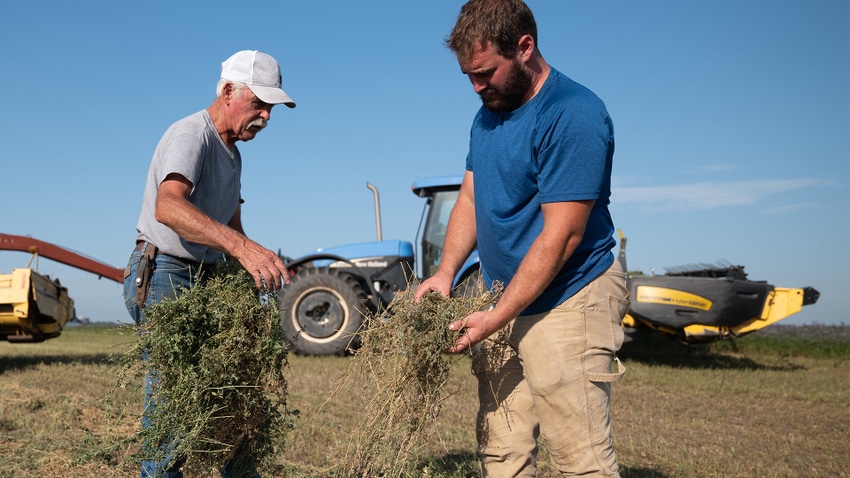April 8, 2024

Kochia is one of the most competitive weeds facing soybean farmers across the upper Midwest and Great Plains. A better understanding of how kochia spreads and adapts can help you control the weed on your acres.
What Makes Kochia Challenging
According to the United Soybean Board, early emerging kochia infestations can rob soybean yield by as much as 70%. There are several reasons the weed is such a threat. The first centers on its unique germination and emergence patterns.
A single kochia can produce up to 30,000 seeds that can begin germination within two to three hours. Seedlings and mature plants grow quickly too, with adult kochia capable of reaching 7 feet tall with root systems extending 15 feet into the ground.
Kochia’s emergence timing can also be unpredictable. While it’s technically an early summer annual, with some emerging as early as late February, the weed can continue germinating well into August in areas like the Great Plains.
Another reason kochia has gained a foothold in the Plains states over the last several years is that it flourishes in hot, dry conditions. During the same period, much of the Plains geography has been dealing with drought.
Finally, according to the International Weed Herbicide-Resistant Weed Database, certain states have kochia populations that are resistant to as many as four sites of action. In the United States, the first official record of kochia resistance is from 1976, when an atrazine-resistant population was found on Kansas corn acres. Since then, the weed has adapted, with resistant populations now found in more than 20 states, affecting at least seven different crops. Atrazine, glyphosate and dicamba are among the active ingredients impacted.1
A Better Way to Control Kochia
Considering all these factors, it’s no surprise kochia creates so many headaches for farmers.
In Menno, South Dakota, Austin Handel was struggling to control kochia in his soybean fields using a dicamba-based trait system, “We had carpets of kochia, I would call it,” Handel said, explaining that, with ongoing drought and dicamba cutoff dates, he didn’t have late-season protection.
So, Handel switched to Enlist E3® soybeans and found a powerful new program to take down his kochia problem: a postemergence tank mix of Enlist One® herbicide and Liberty® herbicide.
“Any field where we applied Enlist One herbicide plus Liberty herbicide, it stayed clean. Versus with dicamba, you’re basically done managing your weeds by the end of June,” Handel said. “When we came back with the Enlist [One] plus Liberty, it knocked [the kochia] out.”
More Kochia Control Tips
While field trials show a postemergence tank mix of Enlist One and Liberty herbicide provides greater than 90% control of resistant kochia, Handel knows a diversified program is essential to stay ahead of the weed.
Enlist field specialists recommend the following:
Control kochia early in spring with tillage or a burndown to prevent yield loss.
Apply the burndown shortly after the first flush, before weeds reach 4 inches.
Use a two-pass program that includes preemergence and postemergence herbicide applications with multiple modes of action and overlapping residuals.
For Enlist E3 soybeans, start with Sonic® herbicide preemergence, followed by a postemergence mix of Enlist One and Liberty herbicides. EverpreX® herbicide can also be added postemergence for residual control.
Remember, during drought, kochia develops a thick cuticle, making herbicide absorption more difficult. Using the right, qualified adjuvants helps overcome this.
Include nonherbicide practices in your program, such as rotation between broadleaf and grass crops.
Find more resources to combat kochia on your soybean acres, including Austin Handel’s full story, at Enlist.com.
1International Weed Resistance Database. 2024. Kochia. https://www.weedscience.org/Pages/Species.aspx
LEGALS
™ ® Enlist, Enlist E3, the Enlist Logo, Enlist One, EverpreX and Sonic are trademarks of Corteva Agriscience and its affiliated companies. ® Liberty and the Liberty Logo are registered trademarks of BASF. The transgenic soybean event in Enlist E3® soybeans is jointly developed and owned by Corteva Agriscience and M.S. Technologies L.L.C. Enlist Duo® and Enlist One® herbicides are not registered for sale or use in all states or counties. Contact your state pesticide regulatory agency to determine if a product is registered for sale or use in your area. Enlist Duo and Enlist One herbicides are the only 2,4-D products authorized for use with Enlist® crops. Consult Enlist® herbicide labels for weed species controlled. EverpreX® and Sonic® are not registered for sale or use in all states. Contact your state pesticide regulatory agency to determine if a product is registered for sale or use in your state. Always read and follow label directions. © 2024 Corteva. 019429 BR (04/24) CAAG4GLUF059
You May Also Like





